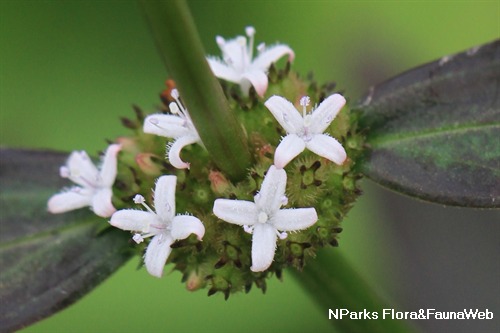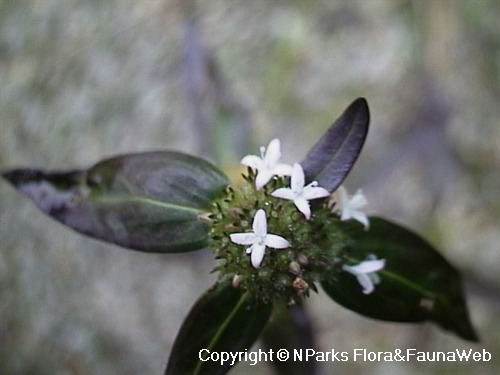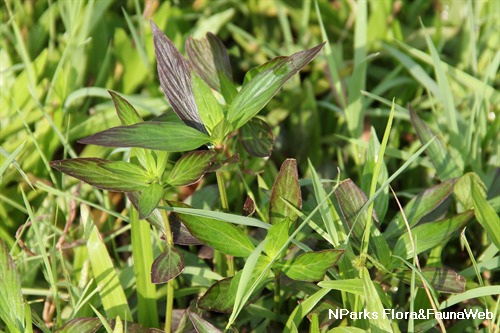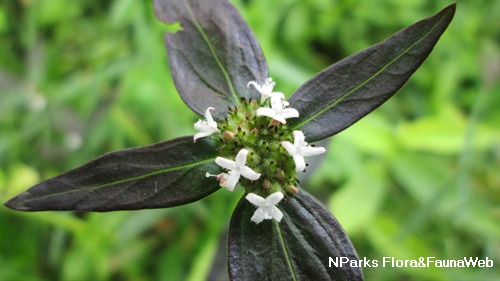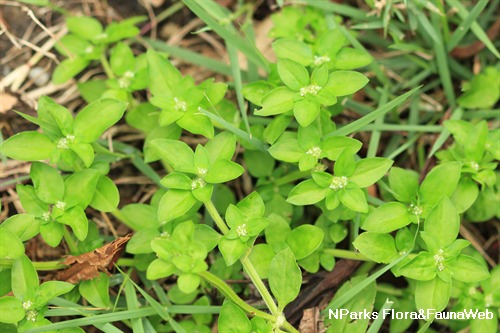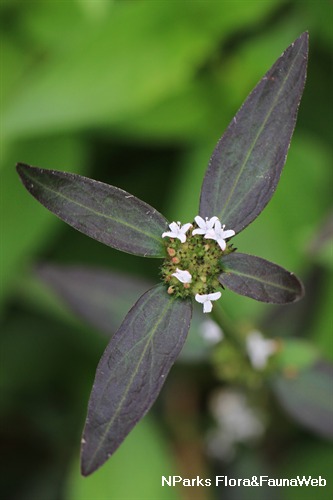
Back
Spermacoce ocymoides Burm.f.
| Family Name: | Rubiaceae |
| Synonyms: | Borreria laevicaulis |
| Common Name: | Purple-Leaved Button Weed |
Name
Classifications and Characteristics
| Plant Division | Angiosperms (Flowering Seed Plants) |
|---|---|
| Plant Growth Form | Herbaceous Plant |
| Maximum Height | 0.5 m |
Biogeography
| Native Distribution | Tropical Asia & Africa |
|---|---|
| Local Conservation Status | Native to Singapore (Presumed Nationally Extinct (NEx)) |
Description and Ethnobotany
| Growth Form | Small, herbaceous plant with an erect growth habit. |
|---|---|
| Foliage | Slightly leathery leaves are lanceolate with entire leaf margin. They are green with purple margins. |
| Stems | Stems are green to purplish. |
| Flowers | Small, white flowers are clustered in 1 cm-wide heads that surround the leaf nodes. Flowers are tubular with 4 pinkish lobes. |
| Fruit | Hairy, elliptical fruits are composed of 2 equal parts and have 4 short sepals at the apex. The fruits split into 2 parts when mature, later releasing their seeds. |
Plant Care and Propagation
| Light Preference | Full Sun |
|---|---|
| Water Preference | Moderate Water |
Foliar
| Mature Foliage Colour(s) | Green, Purple |
|---|---|
| Mature Foliage Texture(s) | Smooth |
| Foliar Type | Simple / Unifoliate |
| Foliar Arrangement Along Stem | Opposite |
| Foliar Attachment to Stem | Sessile |
| Foliar Shape(s) | Non-Palm Foliage (Lanceolate) |
| Foliar Venation | Pinnate / Net |
| Foliar Margin | Entire |
| Foliar Apex - Tip | Acuminate |
| Typical Foliar Area | Microphyll ( 2.25cm2 - 20.25 cm2 ) |
| Leaf Area Index (LAI) for Green Plot Ratio | 4.5 (Shrub & Groundcover - Dicot) |
Floral (Angiosperm)
| Flower & Plant Sexuality | Bisexual Flowers |
| Flower Colour(s) | White |
|---|---|
| Flower Grouping | Cluster / Inflorescence |
| Flower Location | Axillary |
| Flower Symmetry | Radial |
| Individual Flower Shape | Tubular |
| Inflorescence Type | Compound Head / Capitulum |
| Flowering Habit | Polycarpic |
| Flowering Calendar | May |
| Flower Size | 3 mm |
| Inflorescence Size | 1 cm |
Image Repository
Others
| Master ID | 433 |
|---|---|
| Species ID | 1729 |
| Flora Disclaimer | The information in this website has been compiled from reliable sources, such as reference works on medicinal plants. It is not a substitute for medical advice or treatment and NParks does not purport to provide any medical advice. Readers should always consult his/her physician before using or consuming a plant for medicinal purposes. |

